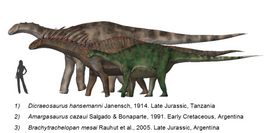Dicraeosauridae
| Dicraeosaurids | |
|---|---|

| |
| Amargasaurus | |
| Scientific classification | |
| Domain: | Eukaryota |
| Kingdom: | Animalia |
| Phylum: | Chordata |
| Clade: | Dinosauria |
| Clade: | Saurischia |
| Clade: | †Sauropodomorpha |
| Clade: | †Sauropoda |
| Superfamily: | †Diplodocoidea |
| Clade: | †Flagellicaudata |
| Family: | †Dicraeosauridae Janensch, 1929 |
| Genera | |
Dicraeosauridae is a family of diplodocoid sauropods who are the sister group to Diplodocidae. Dicraeosaurids are a part of the Flagellicaudata, along with Diplodocidae. Dicraeosauridae includes genera such as Amargasaurus, Suuwassea, Dicraeosaurus, and Brachytrachelopan. Specimens of this family have been found in North America, Asia, Africa, and South America.[1] In 2023, a dicraeosaurid fossil was discovered in India for the first time.[2] Their temporal range is from the Early or Middle Jurassic to the Early Cretaceous.[3][4][5] Few dicraeosaurids survived into the Cretaceous, the youngest of which was Amargasaurus.[6]
The group was first described by German paleontologist Werner Janensch in 1914 with the discovery of Dicraeosaurus in Tanzania.[7] Dicraeosauridae are distinct from other sauropods because of their relatively short neck size and small body size.[3]
The clade is
Classification

Dicraeosaurids are a part of Diplodocoidea and are the sister group to Diploidocidae. In the past two decades, the known diversity of the group has doubled.[6] However, the classification of Suuwassea as a dicraeosaurid is not universally agreed upon.[6][8] Some phylogenetic analyses have found Suuwassea to be a basal diplodocoid instead of a dicraeosaurid.[8] One 2015 analysis has even found Dyslocosaurus as a member of Dicraeosauridae.[10] A 2016 reappraisal of Amargatitanis has placed it into the Dicraeosauridae, as well.[11] In 2018 a new genus, Pilmatueia, was described.[12]

Dicraeosaurids are differentiated from their sister group, diplodocids, and from most sauropods by their relatively small body size and short necks.[13] Dicraeosaurids are advanced sauropods within the monophyletic clade Neosauropoda, which is generally characterized by gigantism. The relatively small body size of dicraeosaurids make them an important outlier relative to other taxa in Neosauropoda.[14]
Phylogeny
There have been several different proposed phylogenies of Dicraeosauridae and the intra-group cladistics are not resolved. Suuwassea is variably positioned as either a basal dicraeosaurid or a basal diplodocoid. The phylogeny published by Tschopp and colleagues in 2015 is as follows:[10]
| ||||||||||||||||||||||||||||||||||
Tschopp includes Dyslocosaurus and Dystrophaeus as dicraeosaurids, two genera traditionally not considered to be part of Dicraeosauridae. The specimens of Dystrophaeus viamelae are highly fragmentary, with only a few bones available for study including an ulna, partial scapula, partial dorsal vertebrae, a distal radius, and some metacarpals. Dyslocosaurus polyonychius also has extremely limited fossil evidence that only includes appendicular elements, and the position of it in Tschopp's phylogeny is therefore considered "preliminary".[10]
Several studies, however, do not include even Suuwassea in Dicraeosauridae, such as Sereno et al. (2007);[13] and JD Harris (2006).[9] Other studies, however, recover Suuwassea as a basal dicraeosaurid, including Whitlock (2010)[6] and Salgado et al. (2006).[15]
Paleobiology
Feeding behavior
As sauropods, dicraeosaurids are obligate herbivores. Due to their relatively small necks and skull shape, it has been deduced that dicraeosaurids and diplodocids primarily browsed close to the ground or at mid height.[6][13] Among the dicraeosurids, only Dicraeosaurus has well-preserved dentition. This makes it difficult for paleontologists to make definitive statements about Dicraeosauridae feeding behavior compared to diplodocid feeding behavior.[16] However, compared to its known relatives, Dicraeosaurus is unique in that it has an equal number of teeth in the upper and lower jaw, though teeth in the lower jaw are replaced more slowly.[16]
Anatomy
Dicraeosaurids are characterized by their relatively small body size, short necks, and long neural spines.
Distribution and evolution
Early Dicraeosaurid specimens have been found in three continents - Africa, South America, and North America. The distribution of species is primarily Gondwonan, with the exception of the North American Suuwassea. The presence of Suuwassea in North America is unique among dicraeosaurids, therefore making the proper taxonomic classification of Suuwassea essential. The group likely first diverged from the diplodocids in the middle Jurassic in North America and subsequently dispersed into Gondwana, with the most diversity in East Africa and South America.[6] Amargasaurus was the latest surviving dicraeosaurid genus, living into the Early Cretaceous period.[6]
Recently from the
Sources
- PMID 24828328.
- ^ a b "The Oldest Plant-Eating Dinosaur Has Been Found in India". New York Times. 19 August 2023. Retrieved 23 August 2023.
- ^ S2CID 4385136.
- S2CID 85748606.
- PMID 30042444.
- ^ ISSN 1096-3642.
- ISBN 978-0520254084.
- ^ S2CID 206091560.
- ^ S2CID 9646734.
- ^ PMID 25870766.
- .
- .
- ^ PMID 18030355.
- PMID 21251189.
- .
- ^ S2CID 85579166.
- ^ a b Daniela Schwarz-Wings, 10th Annual Meeting of the European Association of Vertebrate Paleontologists. Royo-Torres, R, Gascó, F, and Alcalá, L., coord. ¡Fundamental! 20: 1-290. 2012.
